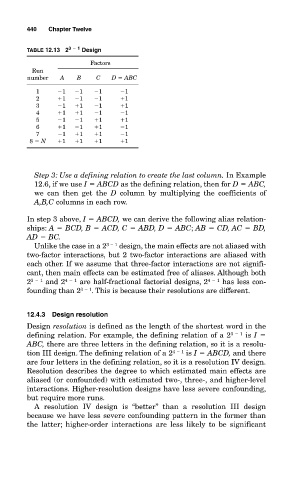Page 481 - Design for Six Sigma a Roadmap for Product Development
P. 481
440 Chapter Twelve
TABLE 12.13 2 3 1 Design
Factors
Run
number A B C D ABC
1 1 1 1 1
2 1 1 1 1
3 1 1 1 1
4 1 1 1 1
5 1 1 1 1
6 1 1 1 1
7 1 1 1 1
8 N 1 1 1 1
Step 3: Use a defining relation to create the last column. In Example
12.6, if we use I ABCD as the defining relation, then for D ABC,
we can then get the D column by multiplying the coefficients of
A,B,C columns in each row.
In step 3 above, I ABCD, we can derive the following alias relation-
ships: A BCD, B ACD, C ABD, D ABC; AB CD, AC BD,
AD BC.
Unlike the case in a 2 3 1 design, the main effects are not aliased with
two-factor interactions, but 2 two-factor interactions are aliased with
each other. If we assume that three-factor interactions are not signifi-
cant, then main effects can be estimated free of aliases. Although both
2 3 1 and 2 4 1 are half-fractional factorial designs, 2 4 1 has less con-
founding than 2 3 1 . This is because their resolutions are different.
12.4.3 Design resolution
Design resolution is defined as the length of the shortest word in the
defining relation. For example, the defining relation of a 2 3 1 is I
ABC, there are three letters in the defining relation, so it is a resolu-
tion III design. The defining relation of a 2 4 1 is I ABCD, and there
are four letters in the defining relation, so it is a resolution IV design.
Resolution describes the degree to which estimated main effects are
aliased (or confounded) with estimated two-, three-, and higher-level
interactions. Higher-resolution designs have less severe confounding,
but require more runs.
A resolution IV design is “better” than a resolution III design
because we have less severe confounding pattern in the former than
the latter; higher-order interactions are less likely to be significant

